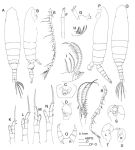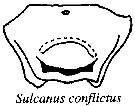|
|
 |
|
Calanoida ( Order ) |
|
|
|
Diaptomoidea ( Superfamily ) |
|
|
|
Sulcanidae ( Family ) |
|
|
|
Sulcanus ( Genus ) |
|
|
| |
Sulcanus conflictus Nicholls, 1945 (F,M) | |
| | | | | | | Ref.: | | | Nicholls, 1945 c (p.502, figs.F,M); Barthélémy & al., 1998 (p.721, genital area); Bradford-Grieve, 1999 b (p.211, figs.F,M, Rem., figs.186, 195); Barthélémy, 1999 a (p.9, Fig.16, L); Boxshall & Halsey, 2004 (p.202, 203: figs.F,M, p. 204: Rem.); Blanco-Bercial & al., 2011 (p.103, Table 1, Biol. mol, phylogeny) |  issued from : J.M. Bradford-Grieve in The Marine Fauna of New Zealand: Pelagic Calanoid Copepoda. National Institute of Water and Atmospheric Research (NIWA). NIWA Biodiversity Memoir, 111, 1999. [p.212, Fig.158]. Female: A, habitus (dorsal); B, idem (right lateral side); C, genital somite (ventral); D, idem (left side); E, A1; F, A2; G, Md; H, Mx1; I, Mx2; J, Mxp; K, P1; L, P2; M, P3; N, P4; O, P5. Male: P, habitus (left lateral side); Q, idem (dorsal); R, right A1; S, P5; T, left P5; U, right P5. Nota: figures E, R-U from Nicholls (1945) from specimens from Orakei Basin, Auckland (New Zealand)
|
 issued from : R.-M. Barthélémy in Thèse Doc. Univ. Provence (Aix-Marseille I), 1999. [Fig.16, L]. Female (from Swan River: Australia): L, external ventral view of double-somite. gp = gonoporal plate. Note the reduction opercular pad (thick arrow) and gonoporal slits (thin arrows). Scale bar: 0.010 mm.
|
 issued from : R.-M. Barthélémy, C. Cuoc, D. Defaye, M. Brunet & J. Mazza in Phil. Trans. R. Soc. Lond., B, 1998, 353. [p.733, Fig.63]. Schematic representation of external genital area in the species studied; Dashed line, limit of the anterior pad and lateral thickenings; shading, posterior pad; dots, genital operculum.
| | | | | Compl. Ref.: | | | Hodgkin & Rippingale, 1971 (p.573, Fig.1, predation); Rippingale, 1981 (p.223); Ough & Bayly, 1989 (p.195, development and feeding); Mauchline, 1998 (tab.47, 48); Newton & Mitchell, 1999 (p.441); Greenwood & al., 2002 (p.17, Table 2); | | | | NZ: | 2 | | |
|
Distribution map of Sulcanus conflictus by geographical zones
|
| | | | | | | Loc: | | | Australia: W, SE & E (Swan River estuary, Georges River, Brisbane River estuary,) & SW (Swan River, Hopkins estuary, Mahurangi Harbour), Tasmania, N New Zealand (Orakei Basin) | | | | N: | 8 | | | | Lg.: | | | (562) F: 1,6-1,4; M: 1,6-1,5; {1,40-1,60; M: 1,50-1,60} | | | | Rem.: | Estuaries; euryhaline (Salinity: 34 to 1,7 p.1000).
Boxshall & Halsey (2004, p.204) confirm after examination of material from the Swan River Estuary the presence from 1 inner seta on the inner margin of the 2nd exopodal segment of P2 to P4, and not 2 in the Nicholls' text (1945, p.209). After Bradford-Grieve (199 b, p.213), Nicholls records specimens from the Swan River differ slightly from the Georges River specimens in that their A1 extend beyond the caudal rami, endopodal segment 1 of P1 has 2 inner setae instead of 3, and there appear to be some slight differences in male P5.
After Newton & Mitchell (1999), the nauplii can be hatched from estuarine sediment samples, particularly in response to salinity changes, and concluded the presence of of dormant eggs, probably in diapause. | | | Last update : 25/01/2018 | |
|
|
 Any use of this site for a publication will be mentioned with the following reference : Any use of this site for a publication will be mentioned with the following reference :
Razouls C., Desreumaux N., Kouwenberg J. and de Bovée F., 2005-2025. - Biodiversity of Marine Planktonic Copepods (morphology, geographical distribution and biological data). Sorbonne University, CNRS. Available at http://copepodes.obs-banyuls.fr/en [Accessed January 02, 2026] © copyright 2005-2025 Sorbonne University, CNRS
|
|
 |
 |






